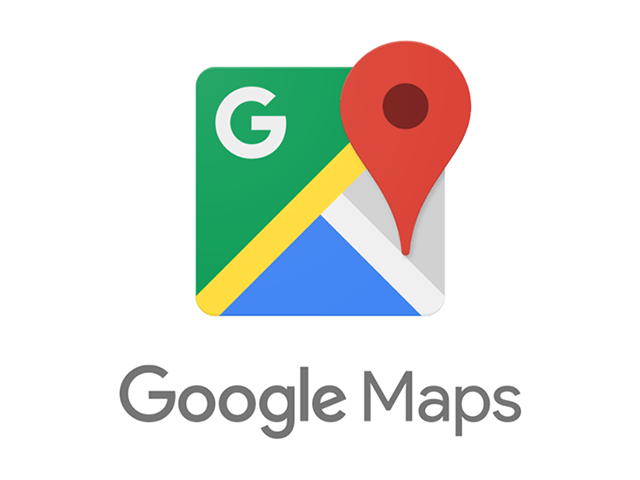The introduction of Google Maps 15 years ago eliminated the need to memorize driving directions, leading to a precipitous decline in the market for paper road atlases. To celebrate its first year, Google completely redesigned the platform, giving it a fresh new look, a ton of new features, and a flashy new app logo.
In 2015, Google adopted a map logo with a pin and the company’s ‘G’ symbol as its most recent redesign for Google Maps. In contrast to previous iterations, however, the iconic pin icon now takes center stage in this one. But let’s find out how they came to this decision and the history behind the simple Google Maps logo.
Overview
Google Maps’ primary function is to map the Earth, which aids in terrain navigation. Previously, this service was only used to get from point “A” to point “B.” However, because it has unique features in addition to step-by-step instructions, it has evolved into a gateway to exploring the world. For example, the app allows you to explore panoramic views of the streets, check the occupancy of public transportation, view the interiors of public establishments, read company reviews, and find the best hotel or restaurant. The website provides detailed information about various regions, which is useful for both travelers and those who simply went shopping.
In early 2005, Google Corporation launched its mapping service. It purchased the project from the Rasmussen brothers, who developed the Tile server with Where 2 Technologies in 2003. They were invited to join Google Maps’ development team so that the famous brothers could improve their concept and outperform all competitors in the field of cartography. The app’s first accomplishment was the “drag and drop” map, which no one else had.
The features were constantly improved and expanded. Users can now access satellite images, panoramic images, and data from aerial surveys. Routes by any mode of transportation can be planned.
Google Maps Logo Evolution
Because the web service is compatible with iOS and Android operating systems, almost all users are familiar with its logo on mobile devices. The Google Maps symbol has evolved. It has progressed from a multicolored verbal sign to a combined logo that includes a gray inscription and a colorful drop-shaped pin – the so-called marker. Google Corporation owns the patent and copyright to this pin.
2005 – 2006
The first version of the program was released in 2005. It was briefly renamed Google Local, and the logo reflected this. The first letter was written in the style of the Google logo. The designers stuck with the corporate serif font and the iconic color scheme of blue (both “g”), red (“e” and “o”), yellow (another “o”), and green (“l”). All of the letters had a gradient and blurred gray shadows.
The second part of the name was placed below the double “oo,” and it was written in a bold sans-serif font with a solid orange background.
2006 – 2009
The service was finally renamed Google Maps in 2006. As a result, the word “Local” was changed to “Maps” on the logo, but the lettering style remained unchanged. The application was expanded to dozens of countries, including Germany, Canada, and the United Kingdom, which was one of the reasons for the rebranding.
2009 – 2010
The word “maps” was added to the right side in 2009. They repainted it blue and lowered all of the letters to keep the style consistent.
2010 – 2013
The “Google” inscription was removed from the glow and gray outline after another program update. The gradient remained, but it became less noticeable.
2013 – 2015
The trend toward simplification accelerated in 2013. Color transitions were removed, and colors were lightened. The emblem change coincided with the launch of a new mapping site, which included many personalized features as well as a view of the Earth from space.
2015 – 2020
Google Maps began using an updated logo in line with Google’s global rebranding. With the same line thickness, a bold grotesque font has replaced the font in the first part of the name. The second half of the lettering was repainted in gray, and the letter “M” was capitalized.
2020 – Today
The most well-known transformation of Google Maps’ visual identity occurred in 2020. This is how the web-based mapping service celebrated its 15th anniversary, along with a new feature expansion in the mobile app. For the first time, a pin appeared on the brand logo, which had previously only appeared on the icon. It’s a stylized icon of an inverted drop with a round hole inside. It represents the beginning and end of the journey. It reflects the online platform’s years-long evolution: from a simple navigation system to a full-fledged assistant and informant.
Google’s signature colors are used to paint the drop-shaped symbol: red, blue, yellow, and green. They are shown as separate blocks, with the blue in two shades: lighter and darker. To keep the logo from looking too mottled, the designers made the lettering completely gray. The first word is bolder than the second, so they can be distinguished visually.
The History of Google Maps Icons
The Google Maps app icon has undergone several changes. The most recent update occurred in 2020 when the developers improved the interface and added several useful features. Previously, the service’s main symbol was a stationery button with a map. The designers simplified this element by removing the hint of a map plan of the area and leaving only a drop pin. In terms of colors and shapes, the icon is consistent with Google’s corporate branding.
2009 – 2012
The 2009 edition included a schematic map of intersecting streets. The roads were yellow and light gray, with brown and dark gray spaces in between. The map appeared to be bent in two places due to the pattern’s division into three color blocks. This made the icon appear three-dimensional, and the shadows at the bottom enhanced the 3D effect even more. On one of the folds was a glowing blue circle, a standard “marker” indicating the user’s location or the endpoint of the route. The designers added radial gradients, shadows, and glow to make the pin appear three-dimensional.
2012 – 2014
The Android app icon was updated in 2012. First, the sheet’s fold lines and shape were altered, resulting in flatter edges. Second, the map’s scale was increased so that it could only fit one yellow intersection, dividing the space into three sections: blue, green, and light brown. Third, the designers changed the color of the pin to red and shifted it to the right side. The left half was occupied by a large white letter “g” in lowercase.
2014 – 2015
The map lost its volume and became two-dimensional after a minor change. It was designed to look like a square with rounded corners by the developers. On a green background, the lowercase “g” was in the upper left corner. Then there was a yellow diagonal dividing line and two triangles (blue and dark gray), separated by a light gray stripe. The red drop pin grew in size and took up space at the point where the two fragments met.
2015 – 2020
The changes in 2015 were minor. Using Google’s original font, the designers changed the lowercase “g” to a capital “g.”
2020 – Today
Google Maps celebrated its 15th anniversary by redesigning the app’s icon. The bottom edge of the pin symbol has been removed in the modern version, and the circle in the center is white. Because the stylized map has been removed, the background has been repainted white. The stationery button is no longer red, though it has been kept. Along with it, blue (two shades), yellow, and green are used – the foundation of Google’s corporate palette.
Elements of Google Maps Logo Design
The Google Maps logo contains relevant graphic elements. Colors, text, and spectacular symbols are among them. They worked together to give the trademark a pleasant personality. Though the logo has been refreshed several times, it has retained its core personality over the years.
Let’s take a closer look at these components.
Colors of the Google Maps Logo
The Color Blue:
Blue is the color of insight. It’s a primary color and one of Google’s own. Despite having several emotions, it indicates transportation and shopping on the map. However, the color blue can represent loyalty, stability, freedom, and serenity. But keep in mind that it can sometimes evoke coldness.
The Color Red:
The color red represents blood and energy. It’s Google’s official color and a primary hue, just like blue. In most fields, it represents longing, romance, joy, and strength. Furthermore, red has been used throughout history to convey anger, danger, lust, and violence. Remember that red is an action-oriented color.
The Color Yellow:
Yellow represents hope and honor. It’s one of Google’s favorite colors, along with blue and red. On the plus side, it represents happiness, freshness, and intelligence. On the other hand, it can foster deception, illness, and jealousy. Remember that yellow attracts attention.
The Color Green:
Green is a healing color. It’s also one of Google’s favorite colors. It represents the outdoors, entertainment, and leisure on Google Maps. Aside from that, the color represents growth, harmony, fertility, and renewal. Unfortunately, it can elicit emotions such as greed and envy.
The Color White:
The location marker icon’s center is highlighted in white. According to most experts, it is a color of goodness. It is associated with purity, humility, perfection, and safety among these people. Furthermore, the color of heaven represents innocence, cleanliness, softness, and illumination.
What Do the Google Maps Icons Mean?
Google Maps is a simple way to find a location. To make it easier for people to find locations, Google Maps uses several icons to represent each landmark. It is common to find unique symbols for schools, roads, hotels, hospitals, and libraries, among other things.
Let’s begin with the well-known (+, -) signs. The plus (+) icon allows you to zoom in on a specific location. This allows you to enlarge the specific location to find more details. The minus (-) icon, on the other hand, allows you to zoom out of a location. There is also a compass-like symbol.
It consists of a dot inside a small circle with four directional points. When you enable Google Maps, this symbol indicates your current location. The magnifying glass is especially useful when searching for location information on Google Maps.
Furthermore, Google Maps employs the exclamation point to indicate traffic incidents. The presence of a worker and a shovel then indicates road construction. A blue letter—M, for example, represents an elevated or underground rail. A blue circle around an airplane, on the other hand, corresponds to an airport.
Other symbols include a tree for a park, a shopping bag for shopping malls, a knife and fork for restaurants, and a glass for bars, to name a few. However, finding the location of businesses is much easier with Google Maps.
Remember that the icons will act as your online tour guide.
Is the Google Maps Pin Registered?
Google has used the pin in a variety of marketing materials, including video games. The pin is registered as a teardrop-shaped marker under US patent laws. The prominent inverted-drop-shaped symbol represents Google Maps locations. It is sometimes referred to as the marker.
What Is Google Maps’ Purpose?
Google Maps serves as a digital map. Its primary function is to provide driving instructions. It now offers mapping and navigation to its billion users. Google Maps, unlike physical maps, provides directions in two and three-dimensional satellite views.
It also allows businesses to include information about themselves on its interface. This makes it easier for users to find them. Again, the app provides a variety of landscape views, such as streets, traffic, and terrain.
The app can also be customized and embedded into web pages using the Google Maps Platform. This is a JavaScript-based advanced development interface.
A Brief History of Google Maps
Google Maps is a digital mapping service provided by Google, Inc. It provides satellite imagery, street maps, and traffic updates in real-time. Lars and Jens Rasmussen, two brothers from Denmark, created Google Maps as a C++ desktop application first.
Google purchased the program in October 2004 and turned it into a digital application. The service was then unveiled on February 8, 2005, after Google added geospatial data visualization and a real-time traffic analyzer. The front end of the interface is built with JavaScript, XML, and Ajax.
Google Earth, which provides three-dimensional views of the world on a desktop, was added the same year. In addition, Google Earth provides travelers with over 36 million square miles of high-definition satellite imagery. Google also released Transit Trip Planner in December 2005.
Read Also: GrubHub Logo: Did Grubhub Change its Logo?
This service displays public transportation schedules and routes for commuters. It started as a separate product but was later integrated into Google Maps, reaching several cities around the world. Google Maps had a miniature view with a movable rectangle by 2007.
This feature primarily indicates the area visible in the main viewport. Google Street View was also released on May 29, 2007. The mobile edition of Google Maps was released on November 28, 2007. It also included the beta version of “My Location.”
My Location determines the user’s current location using the GPS capabilities of mobile devices. Google Maps was added to the Android operating system on September 23, 2008. The iOS version was released in 2012.
Google Map Maker was added to the America interface on April 19, 2011. This enables users to make changes to the map in real-time without relying on third-party firms. Then, in June 2012, Google began mapping Britain’s rivers and canals in collaboration with the Canal and River Trust.
Read Also: Spider-Man Logo: Evolution, History, Meaning
Google released new satellite imagery on June 27, 2016. First, the company acquired it from Landsat 8, which contained approximately 700 trillion pixels of new data. The company then purchased Urban Engines, a mapping analytics company, in September 2016.
Google’s mapping service was updated on October 16, 2017. It provided access to several images of planets and moons. Google Maps introduced three-dimensional globe viewing in August 2018. In January 2019, it was followed by a speed trap and camera alerts.
Google introduced an incognito mode in December 2019. This enables users to access locations without having to save entries to their Google accounts. Then, to commemorate its 15th anniversary, it released a new app symbol in 2020.
Conclusion
Google purchased a C++ desktop application in October 2004. Lars and Jens Rasmussen, two Danish brothers, designed it. Google transformed the app into a digital mapping application by purchasing ZipDash and Keyhole.
Google Maps was eventually released on February 8, 2005. Then, in September 2005, Google updated its satellite imagery to show the New Orleans flooding. Then, two years later, it unveiled its Mobile 2.0 app. This package included a beta version of “My Location.”
Google also announced the Android app release on September 23, 2008. The app was then released in the Apple store four years later. Finally, Google unveiled its newest app icon to commemorate its 15th birthday. It was released in February 2020 and featured a pushpin next to its wordmark.
This new vibrant trademark represents the company’s innovative evolution over the years. The original logo, on the other hand, was a wordmark with the captions Map and Beta below it. Following this first logo, Google has used several others to convey its service mission.
Despite the changes, the company has worked hard to maintain consistency in its visual identity.
Related Articles
- Google Business Profile: Meaning & Best Easy 2023 Guide
- BUSINESS PROCESS MAPPING TOOLS: Uses, Free Tools & Guide
- BUSINESS PROCESS MAPPING: A Definitive Guide
- The Best Professional HAIR DYE BRANDS & What You Should Know!!!
- GOOGLE MAPS RANKING: How to Increase Site Ranking, SEO, & Checks






